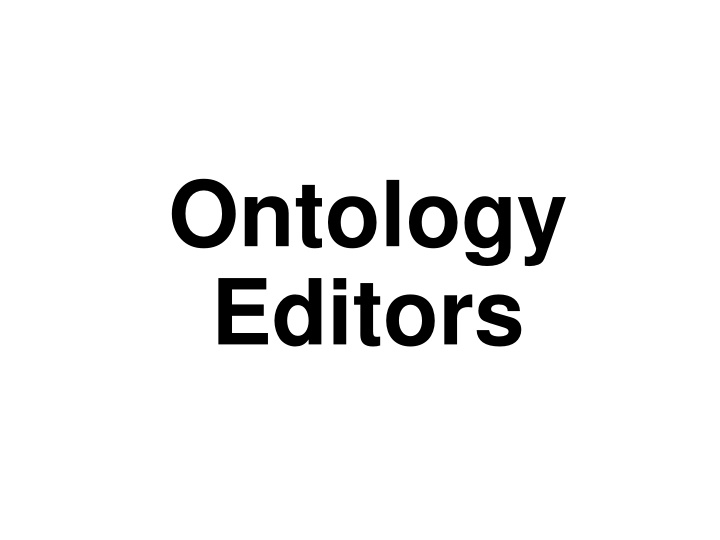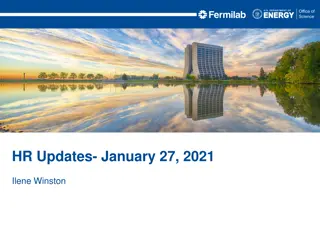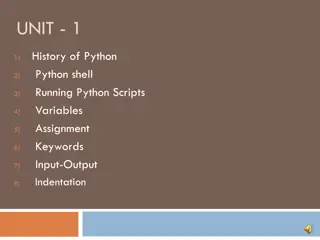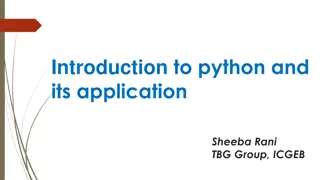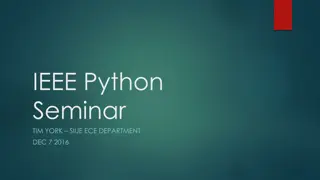Comprehensive Guide to Ontology Editors and IDEs for Ontologies
Explore a wide range of Ontology Editors and Integrated Development Environments (IDEs) for managing ontologies efficiently. From simple text editors to advanced IDEs like Protégé and Web Protege, learn about various tools and syntax options available. Dive into Ontology Editors like Protégé 4.3, Web Protege, YAS (Yet Another Syntax), Manchester OWL Syntax 7 & 8, and understand their features and functionalities. Discover how data values and datatypes are handled in ontology management. Enhance your ontology editing experience with these versatile tools and best practices.
Download Presentation

Please find below an Image/Link to download the presentation.
The content on the website is provided AS IS for your information and personal use only. It may not be sold, licensed, or shared on other websites without obtaining consent from the author.If you encounter any issues during the download, it is possible that the publisher has removed the file from their server.
You are allowed to download the files provided on this website for personal or commercial use, subject to the condition that they are used lawfully. All files are the property of their respective owners.
The content on the website is provided AS IS for your information and personal use only. It may not be sold, licensed, or shared on other websites without obtaining consent from the author.
E N D
Presentation Transcript
Ontology Editors
IDEs for Ontologies Some people use simple text editors Doing this with the XML serialization will drive you crazy Using Turtle or an abstract syntax works well Others prefer an IDE Good IDEs include support for reasoning, visualization, and more Prot g is very a very popular IDE From Stanford, free, lots of plugins TopQuadrant Composer is also good Feature rich but expensive ($600 for a single academic license)
Protg 4.3 http://protege.stanford.edu/ Free, open source ontology editor and KB framework Predates OWL, still supports earlier Frames representation In Java, extensible, large community of users V4.3 supports OWL 2 but missing other features (e.g., SPARQL) v3.5 version has missing features, but only supports OWL 1
YAS: Yet Another Syntax Neither OWL's official abstract syntax nor XML serialization is easy to read or use Prot g uses the Manchester syntax Simpler and more compact: some and only , not someValuesFrom and allValuesFrom A W3C recommendation (http://bit.ly/manSyn), used in the OWL 2 Primer (http://bit.ly/OWL2Pri) Class: man Annotations: rdfs:label "man" EquivalentTo: adult and male and person
Example Person and hasChild some (Person and (hasChild only Man) and (hasChild some Person)) The set of people who have at least one child that has some children that are only men (i.e., grandparents that only have grandsons) 9
Data values and datatypes Data values typed or untyped (e.g., int, boolean, float) Constants with or w/o type, e.g.: hasAge value "21"^^long Use datatype names as classes: hasAge some int XSD facets, e.g.: Person and hasAge some int[>= 65] Ranges: Person and hasAge some int[>= 18, <= 30].
Demonstration We ll use Prot g OWL v4.3 to implement a tiny ontology for people Start by downloading and installing Prot g 4.3 You will need Java You may want to install Graphviz Configure Prot g E.g., select a reasoner to use (e.g., HermiT or Pellet)
A basic workflow Think about usecases Preliminaries Choose namespace URL, import other ontologies used Identify and define classes Place in hierarchy, add axioms and run reasoner to check for errors or omissions Identify and define properties Place in hierarchy, add axioms, run reasoner Add individuals & reasoner to check for problems Add comments and labels Export in desired formats, maybe upload to Web
More workflow steps Use OOPS to find common ontology pitfalls Link concepts (and individuals) to common ontologies (e.g., Dbpeia, foaf) Generate visualizations Produce documentation Develop examples with your use case(s) Encode data, describe in VoID (Vocabulary of Interlinked Datasets), add to LOD cloud
Demonstration Use Prot g OWL (v4.3) to build a simple ontology for people based on the following People have just one sex that s either male or female, an integer age, and two parents, one male, one female A person s grandparent is the parent of their parent Every person is either a man or a woman but not both A man is defined as any person whose sex is male and a woman as any person whose sex is female A boy is defined as a person whose sex is male and whose age is less than 18, a girl is A person is either an adult or (age >18), minor (age <18)
Test cases Some possible test cases Alice parent Bob . Bob parent Carol Alice grandparent Carol Alice parent Bob . Alice parent Don. Contradiction Alice parent Bob . Pat parent Bob Pat a female Alice parent Bob . Gwen parent Bob . Alice owl:sameAs Gwen AllDifferent people Alice F Bob M Carol F Don M Edith F Pat ? Other people Frank M Gwen F
